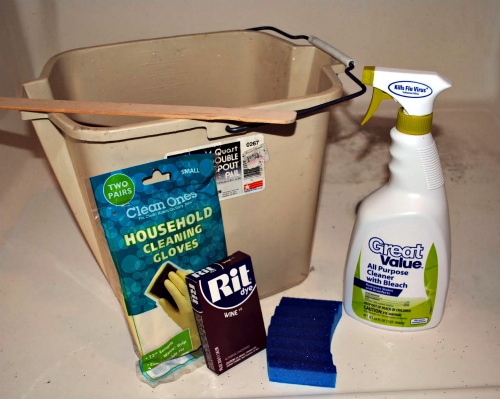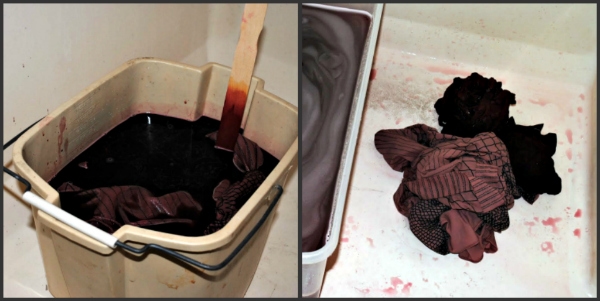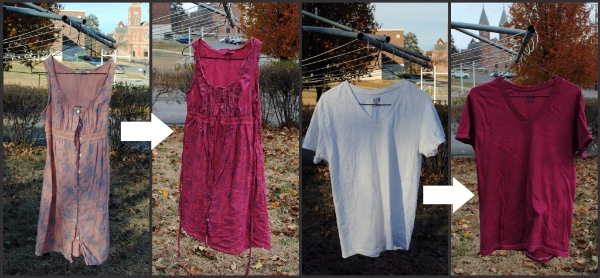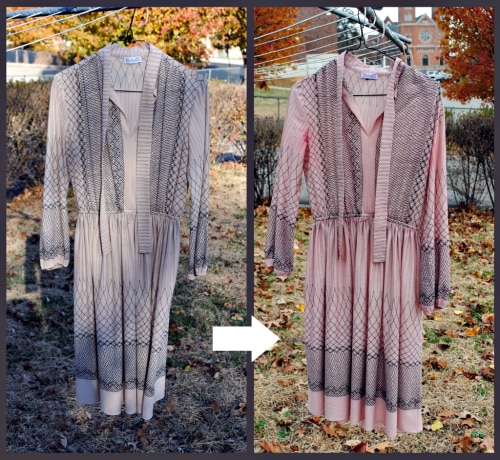
Last February, Lucky Magazine did a great DIY feature about using dye to give clothes a new lease on life, and ever since, I’ve been dying (ha!) to try it! But dyeing clothes is a little bit scary, even if the back of the box and website make it sound easy. Finally, I decided to give it a try with college girls in mind and I’m going to share my experience with all of you!
I’ve done some experimenting with techniques and kinds of fabric to help you decide if dyeing is right for you. Read on for all the tips!
Table of Contents
Methods of Dyeing Clothing
The Rit website and the packages agree that using a washing machine is the easiest way to dye fabric, however that is probably not the best option for most college students who are either using public washing machines or renting one along with their house or apartment.
Instead, another popular method, which is the one featured in this article, is the bucket method, which works best for smaller pieces. For step by step how-tos with other methods check out the Rit Dye website.
Dyeing Clothes: The Supplies

Make sure you have all of these things ready to go before you start. Believe me, you don’t want to get part of the way into the process before you realize something is missing.
Here’s what you need:
- Rit Dye (I used Rit Dye Wine 10 in powder form)
- A bucket to dye the clothes in
- Bleach cleaner (this one works well)
- Sponge or rag to clean up with
- Rubber gloves
- A stirring stick
- Clothes or fabric to dye
- A smaller disposable container to pre-dissolve the dye in
- A hot water source
- Detergent
- Salt (optional)
- A washing machine (to wash the already dyed clothes)
The Dyeing Process

These instructions will be more of a summary with some tips of my own thrown in. Do not attempt to dye anything without fully reading the instructions on the label of the dye you are using.
1. Fill your bucket with enough hot water to submerge your fabric.
The ratio is three gallons of water for every package of powder dye, but I only used two gallons to up the concentration and have a more potent dye.
2. Pre-dissolve the dye in two cups of hot water.
Add the dye, one tablespoon of detergent, and a cup of salt (optional) to the hot water. (The Rit website recommends using salt for more intense color when dyeing fabrics containing cotton, rayon, ramie, or linen, but you will still get decent results without it.)
3. Soak all clothes in hot water and uncrumple them.
This step is very important because the clothes must be as smooth as possible going into the dye so that they dye evenly.
4. Add clothes to the dye bath.
To make sure your colors are perfect, dip a test garment or paper towel in the solution. If it’s too light, then add more dye to achieve your desired shade.
5. Stir, stir, stir.
Keep the clothes in the dye bath at least ten minutes, but as long as 30 minutes, depending on the shade you’re going for. Wear gloves as you do this so that you can handle the clothes if needed.
6. Remove the clothes and rinse, first with hot water, then cold until the water runs clear.
I used a huge clear tub in the shower to do this, which contained the mess, but the process was still fairly arduous.
7. Wring out the clothes
Thoroughly and throw in the washing machine with a standard amount of detergent. Wash and dry as normal.
8. Clean up.
I did all the rinsing in my shower in a large tub and I poured out the dye water from the tub when I was done. Everything looked a little bit pink afterwards, but using a bleach cleaner worked perfectly. There were no spots I couldn’t get out. Do take care to be thorough, though, as any dye that stays longer is more likely to stain.
What Worked
Both 100% cotton items, the shirt and the dress, dyed wonderfully, though they didn’t end up as dark as I expected. Even though the dress was a pink color and had both a design and lace with a different texture, the color took well.
My take away from this: Cotton should be your go-to fabric if you’re seriously considering a dye job, and even if the clothes look really dark when you take them out of the dye bath, a lot of the color will wash out both when you rinse and in the wash.

What Didn’t Work
I was skeptical, but believe the label: Polyester does not dye well. This vintage, 100% polyester dress was not ruined, but it became only a shade or two darker than its original color, despite the high concentration of dye in my dye bath.
Steer clear of polyester if you’re looking for anything dramatic, but if a shade or two different is what you’re going for, give it a try!

The Bottom Line
If you have some time to kill, a great piece of clothing in a so-so color, and some ambition, definitely give Rit Dye a try. But if you’re a fair weather DIY-er, take heed, it’s a lot of work, but the results can be worth it. Just make sure you have a space that you can clean thoroughly to do the dyeing in!
Your turn to talk!
Have you used fabric or leather dye before? Did it work? Would you recommend it to other people? Are you adventurous enough to try it yourself? Let me and your fellow readers know in the comments!
Related posts:

Hi I dyed my clothes successfullx by using your procedure But how to dye a sky color.Thanks
I’d like to dye a vest, parka & cargo pants all in one go. I am going to use minimal water to maximize the concentration, I also am going to use a black and a dark blue liquid form of the Rits Dye. My questions are as follows…
1) should I bleach the pieces before hand? The vest is a tan, the parka is a dark green & the pants are a cool grey. All three of them are mostly cotton.
2) How effective is it if i leave the pieces in the mix overnight? Does that do anything at all? or just wastes time?
3) the vest in particular has a lot of stuffing and I am afraid that it might soak up a lot of the water/dye, so would it help if i cut the outside of the vest off and just dye that part black? While leaving the inside (which is already black) and all of the stuffing out of the mix?
Thanks for the advice in advance.
I predict it might take a while for a response (if I get one at all) so I am gonna go ahead and proceed and I will inform everyone of the outcome.
Thanks again.
Having trouble dyeing my navy blue jacket, the color was kind off faded so I decided to dye it to restore its color, but the jacket’s color still seemed faded after drying. I’ve dyed it two times using two packets of dye everytime, 4 tablespoons of vinegar and 1 tablespoon of salt. I was wondering if the fact that it was 60% cotton and 40% polyester had an effect on the how it could absorb the dye? Any suggestions?
HI my name is dorothy i’m having so much trouble trying to dye white pants black i have so many times,PLEASE HELP.
What if you’re trying to go from a red to a black? Do you think that would work with extra dye?
I have a sweater that has a leather front. I would like to dye so it looks better its still In good condition. The color has faded a little?
Timothy, it will change the lettering to a darker shade, but it would be legible still.
thsnk
Polyester is a synthetic almost plastic-like thing that doesn’t “soak” in dyes like RIT, which is a combination of two dyes. Cotton and other natural fabrics can. My take on it is that polyester almost has to be melted again to take a specific dye not found in RIT (a disperse dye). Nylon can be similarly hard to dye, but others report success with enhancing the acid-dye by pre-soaking with vinegar and using vinegar in the dying process. I tried to dye some nylon elbow-length gloves using that, and was only able to turn the white a dingy mix of grey and purple..
http://www.pburch.net/dyeing/dispersedye.shtml
Please do one on how to re-dye dark wash jeans! Even though I don’t dry them my college washers kill the color of my jeans =(